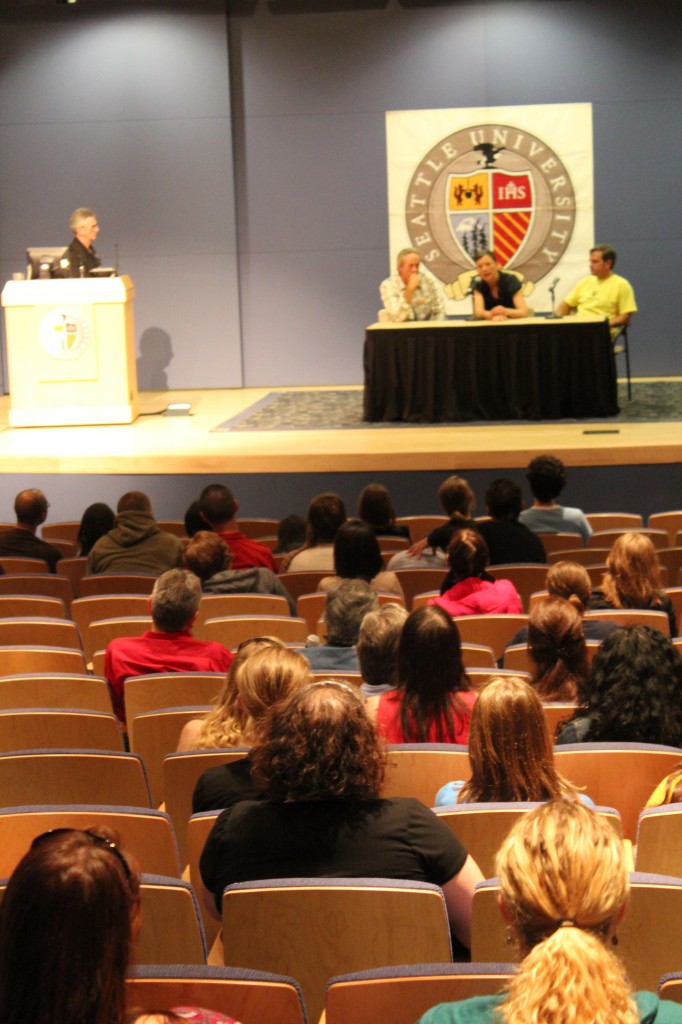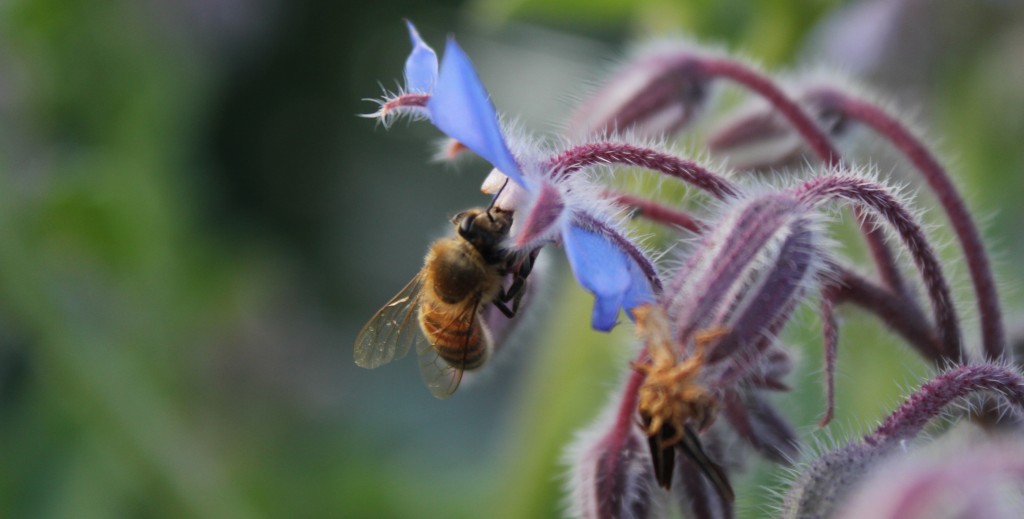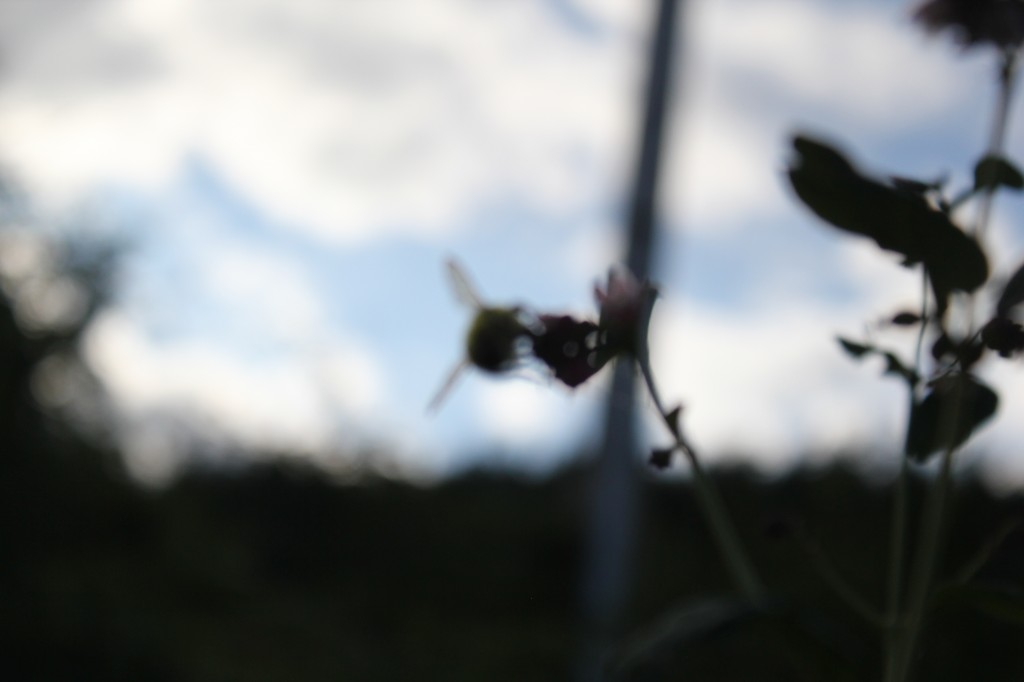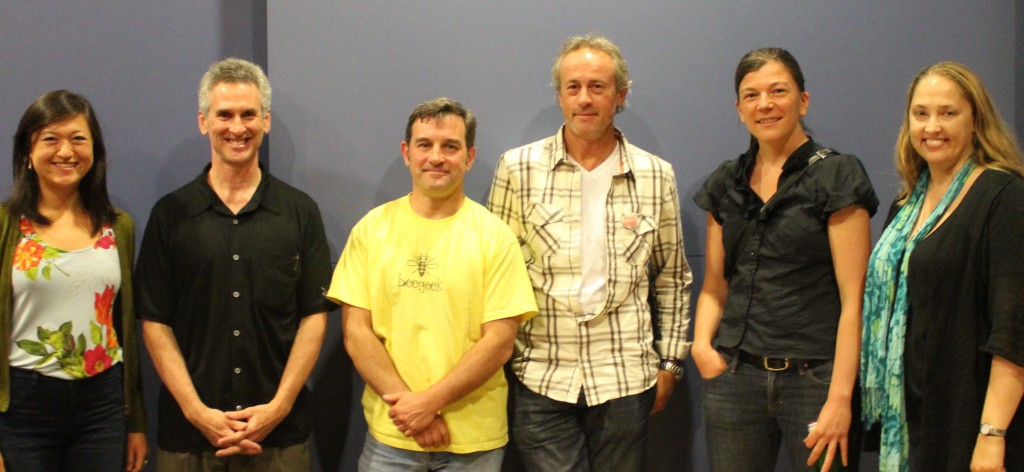How We Can Bee the Change: Pollination Panel Discussion at Seattle U
- by Vera Chang
Like the honey bee, the sage should gather wisdom from many scriptures. – Bhagavad Gita
Since I’m allergic to many bees and wasps, I fear getting stung. Once, my reaction to a sting was so severe that I went into anaphylactic shock in rural China and was saved by a perilous trip to a hospital nearby. But no matter how negative my body’s response is to bee venom, I want to live in a world with bees. Bees are the insects responsible for the pollination of many foods I love to eat: fruits, vegetables, nuts, spices, flowers, seeds, and beans. Roughly one-third of our world’s food supply is dependent on bee pollination. Our lives, in fact, depend on bees.
Recently at Seattle University, Bon Appétit Management Company and Slow Food Seattle cosponsored a free showing of the new documentary Vanishing of the Bees, which was directed by George Langworthy and Maryam Heinen and narrated by actress Ellen Page. An astonishing 350 people attended the showing and the panel discussion with local beekeepers that followed.
The film is an eerie and engaging portrayal of the mysterious “vanishing bee syndrome” called Colony Collapse Disorder (CCD). This occurs as the abrupt mass disappearance of honey bee (Apis mellifera) colonies. It is estimated that one-third of honey bee colonies in the United States have vanished without a trace. In some areas, honey bee losses are as high as 75 percent.

While nobody has hit on the exact cause of CCD, scientists and beekeepers in Vanishing of the Bees described it as the likely result of a combination of factors that have weakened bees’ health, including:
- Exposure to systemic pesticides designed to kill crop pests: these pesticides, absorbed by plants, can also kill non-target insects like bees
- Invasive parasitic mites
- Viruses that target bee immune systems
- Inadequate food supply due to the expansion of agricultural monocultures and loss of global biodiversity
- Poor nutrition: in commercial hives, sugar syrups and even high fructose corn syrup have replaced honey as feed)
- Climate change
- Genetic engineering: In commercial hives, bee colonies are unable to produce a queen through natural mating processes. Every one to two years, the reigning queen is decapitated and a new, queen bee bred through artificial insemination is introduced to the colony. Often, she arrives after being shipped a across the country, stressed and exhausted. Artificial breeding can weaken colonies’ abilities to respond to local conditions and build natural resilience.
A world without bees would mean more than a world without honey. Agricultural experts in the United States estimate the crop pollination performed by bees to be worth $4 billion to $6 billion per year. The effects of CCD will therefore be economic, political, and ecological. Global biodiversity and agricultural production will decline, and food insecurity and prices will soar.
While I plan on avoiding up close physical contact with bees as best I can, I want to do all I can to help keep them healthy and buzzing. Here are some ideas I compiled to help us ‘bee the change’ we want to see. Thank you to Vanishing of the Bees, Slow Food USA, and event panelists, Corky Luster of Ballard Bee Company; Sarah Bergmann of The Pollinator Pathway; and Rob Stevens of Fairview Farm Apiary, and moderator Buzz Hofford of Bon Appétit Management Company at Seattle University for sharing their insight.
I highly recommend watching Vanishing of the Bees if you haven’t already. You can find a screening here and get information for organizing your own film showing here.
Bee the Change:
- Raise awareness and spread the buzz. The first step to activate change is education. A great place to get updated information on bees and CCD is the Vanishing of the Bees Facebook Page.
- Vote with your fork to support sustainable and organic production practices and those that maintain native pollinators. Originally war chemicals were used to kill people and today pesticides are used to kill insects. Chemical sprays remain harmful not only to people but also to beneficial insects. The bees that land on sprayed crops become disordered, confused, and fall off. Scientists believe that the pesticides affect the bees’ nervous systems.
- Support organic honey production, your local beekeepers, and producers of rare honey. Organic beekeeping means that honey bees are raised without sugar syrups, artificial pollen, or miticides. Visit your local farmers market or co-op.
- Use natural cleaners and pest remedies. These are safer, more effective, and less expensive than toxic chemicals, such as insecticides and herbicides.
- Grow your own food and create bee friendly habitats. Maybe you want to plant an organic garden or simply grow flowers on your windowsill. Choose pollen- and nectar-rich plants, such as sunflowers, ferries, gourds, and lavender. Leave a tray of water out for the bees to drink. And for extra fun, float recycled wine corks in the water give the bees a place to land and rest as they drink.
- Join The Great Sunflower Project. Help gather information about our urban, suburban, and rural bee populations. Plant Lemon Queen sunflowers, Bee balm, Cosmos, Rosemary, Tickseed, Goldenrod, and/or Purple coneflowers and track the quality of your yard’s pollinator service. This is a great way to contribute to research as well as learn more about what’s happening in your backyard.
- Raise bees. Michelle Obama put in a bee hives at the White House Garden. This is a great way to help restore the environment and create a more diversified and thus stronger food system. Here are some of the upfront costs to factor in when starting a hive: Complete hive-setup should cost approximately $175-200, or $300 tops, depending on how all-out you go with gear. A beekeepers’ veil will cost approximately $20. Gloves, a smoother, two hive tools, plus bee brush will be approximately $100. Finally, a package of bees (three pounds of bees, including a queen) will cost $75-110, plus additional costs of feed and medication, if needed.
- Get political. Sign Slow Food USA’s petition or write to the Environmental Protection Agency on your own to urge the Office of Pesticide Programs to help safeguard our food system.


